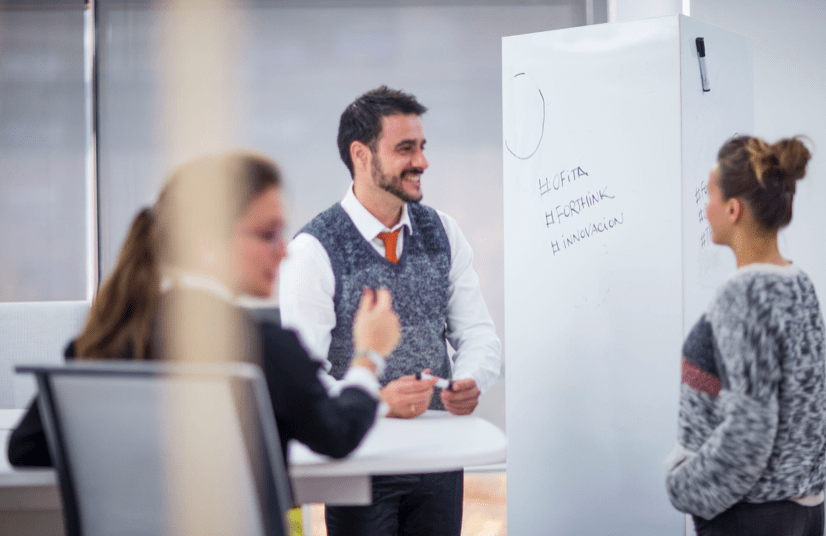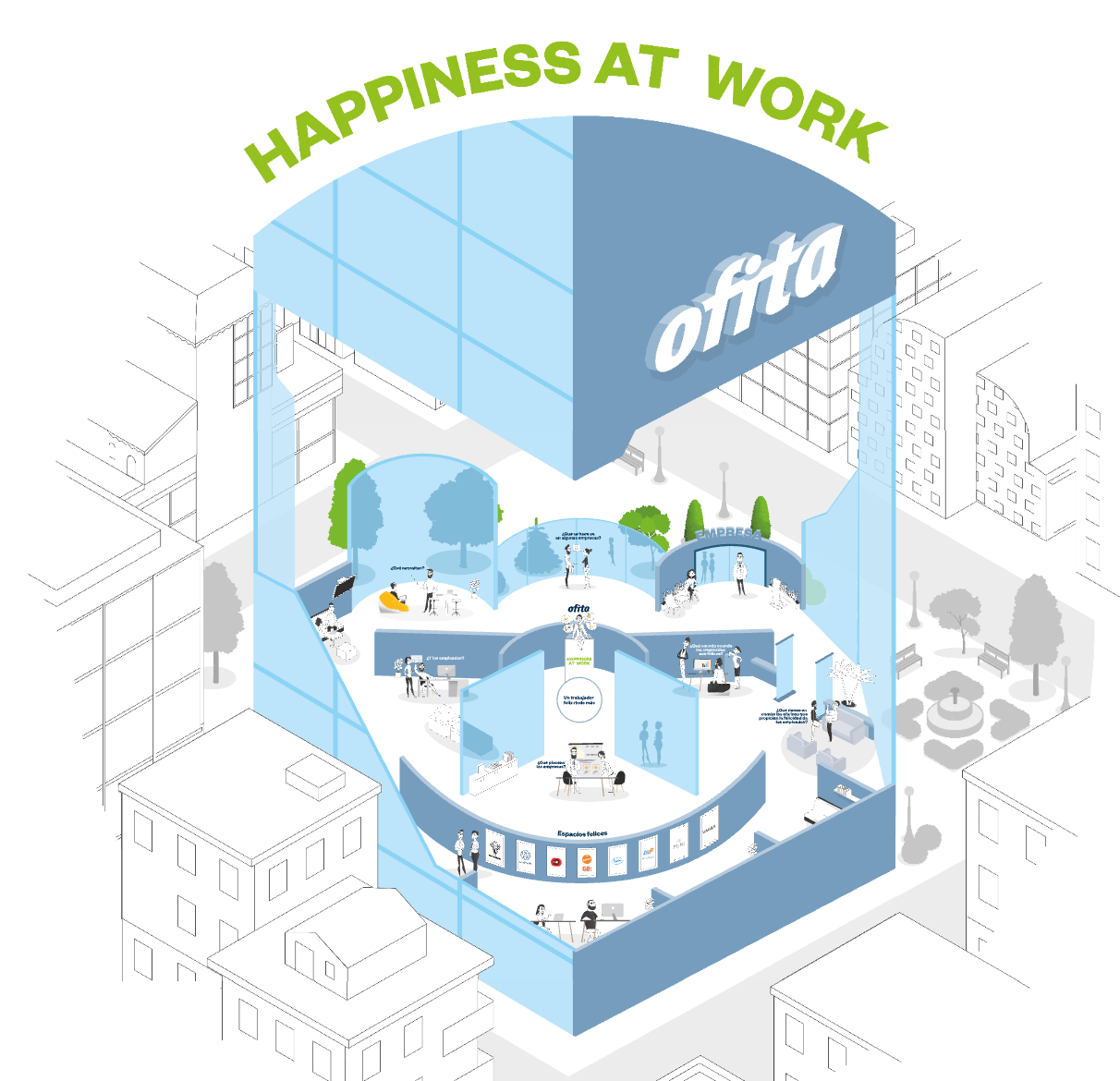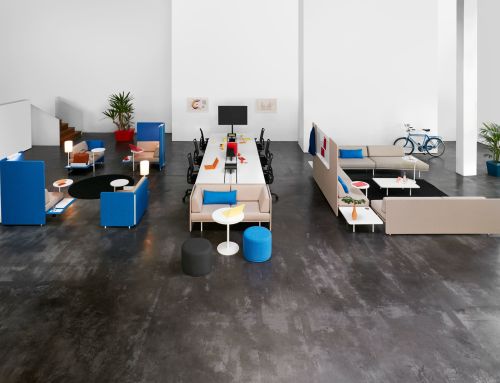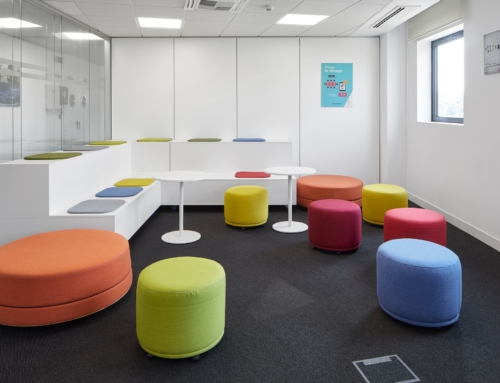Happyness at work – Employees most committed with their workplaces are happier and respond being up to 30% more productive.
Benefits do not result only in productivity. It has been verified that happy employees can increase their creativity up to 86% and improve their health up to 20%. In this context, it is important for companies to realise the advantages of turning into places increasingly comfortable, where both parties, employee and employer, may obtain positive results benefiting each other; a trend which is expected to gain more traction in the future, when millennials will hold management positions.
So much so that over 90% of today’s Ofita’s clients consider the happiness of their employees in the design of offices while this percentage was 50% lower 5 years ago and 20% 10 years ago.

What do we need to be happy at work? Flexibility, a good manager and a good environment are three of the requirements necessary to be happy at work. Indeed, the design of the work space impacts significantly on the happiness of the employee and for this reason, employers are ever more conscious of its importance.
The work space should not only satisfy basic needs of people but also their deepest emotional needs. For example, 95% of companies are concerned about the happiness of their employees in their leisure/relax areas.
Ten Commandments of the “happy office” according to Ofita
-
Social and informal spaces – happyness at work
Due to the ever changing nature of how, when and where people work, organizations need bigger informal spaces where people can meet, make private calls or simply enjoy their leisure time. Agoras, leisure rooms, cafes, lounges…they all encourage sound connections between people and favour knowledge transmission. Here is where employees feel comfortable; where they coexist, where different talents flow and where innovation ecosystems are created.
-
Collaboration environments
Headquarters concerned about the wellbeing of employees stand out for having something in common: they combine concentration areas with open and collaborative spaces at the same time as they minimize the number of tables assigned to one specific person. Ever more frequently, offices are “non-territorial” with unassigned workplaces. The reason is based on the fact that they encourage teamwork, camaraderie and joint targets. This gains special relevance when considering that new generations find common areas as a requirement for an ideal environment.
-
A correct illumination
It has been confirmed that both physical and psychological wellbeing of people can mark a significant turning point in the scope of productivity. For this reason illumination shall guarantee visual comfort to work efficiently and create an appropriate working atmosphere.
-
Greater contact with nature and natural light
Wood, indoor gardens, views to the outside and open air spaces to take a break from the day are some of the new resources small companies are betting on to give more importance to nature within their working environment. This can be boosted along with the incorporation of a biophilic design focused on the insertion of environment aspects both in architecture and decoration.
-
Correct circulation of employees and occupational health
Given that most people spend around eight hours seating in front of a computer, it is necessary for companies to worry about offering appropriate spaces to provide a correct circulation throughout the day. To offer further comfort, this has to be accompanied with ergonomic furniture, i.e., adaptable to achieve greater comfort and efficiency of different functions and even of adaptable tables for the user to work either standing or seating. Without forgetting the importance of providing workplaces with ergonomic chairs guaranteeing healthy postures during working hours.
6. Health quality
It is enough to be aware of the importance for the human body of the air we breathe, to understand that worrying about the improvement of its quality is a key aspect for offices. Something that serves this objective is to rely on ventilation systems both natural and artificial and to have plants which generate oxygen throughout the day. Some studies have revealed that offices with plants make employees feel happier, focused and productive. One more reason to introduce them.
7. Noise isolation, Farewell to open space?
Acoustic is among the main aspects with which people are not satisfied. Therefore organizations have to guarantee good noise isolation system in open spaces. Moreover and above all, the open space has to coexist with other closed spaces which offer greater concentration or require certain privacy such as for example, making phone calls to a specific client. A good acoustic system can improve motivation up to 60%.
8. Home comes to the office – Happyness at work
Until a few years ago, offices were impersonal spaces formed basically by chairs, filing cabinets, desks and files. Today that paradigm has fortunately been left aside hand in hand with its domestication, i.e., turning more to home environments where motivation, quality of life and employee satisfaction can be increased. This is achieved with changes in the configuration and design of furniture to include simple details such as curtains, cushions and different decorations.
-
Customized and flexible spaces
Headquarters are ever “more human” fulfilling the needs of each of their employees. Flexibility both regarding time and spatial or functional has an essential role; i.e., adapting the space and furniture to the requirements of the employees depending on the time and activity.
-
Towards a paperless office and strategic use of colour
The premise is that if the office is physically organized, the employee will also have mental organization. It will hardly perform its duties correctly without a comfortable environment where feeling comfortable. Some keys to achieve this goal go along with the reduction of paper in favour of digital format, and making a strategic use of colour. Specialists agree that strategically designed spaces depending on colour increase productivity and wellbeing of employees and boost better brand communication.





